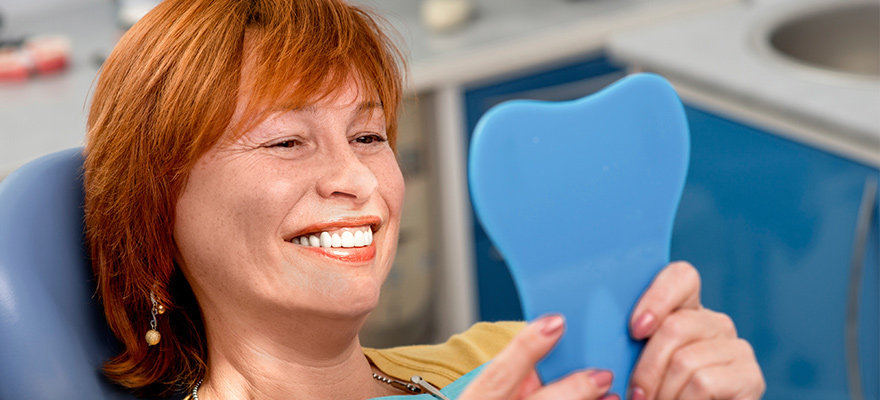
Dental FAQs
Our professional dental team at Short Pump Dental strives to go above and beyond to meet the dental needs of families in Short Pump and surrounding areas. We're proud to offer a wide range of dental treatments to give you a healthier and more attractive smile. Not only that, but we also pride ourselves on our dedicated, compassionate care. We want you to be fully aware and knowledgeable about any dental treatments you may need and how to best take care of your oral hygiene. As your trusted family dentist, we'll be glad to share with you the answers to some of the most frequently asked questions we receive.
How Often Should I See a Dentist?
The American Dental Association (ADA) recommends visiting a dentist at least twice a year for a check-up and a professional cleaning. Our office also recommends at least two visits per year.
What Should I Expect During My Appointment?
One of our staff members will compile your medical and dental history during your first visit. We'll then examine your teeth and gums, screen you for oral cancer, perform X-rays of your teeth, and complete a TMJ (temporomandibular, or jaw, joint) exam. After we review your dental profile, we will discuss a diagnosis with you. If treatment such as a root canal (endodontics), braces (orthodontics), or oral surgery is needed, we will plan to treat you in our office or refer you to a specialist. We will discuss your options for treatment, the fee payment, and then help you determine the best plan to fit your needs.
During regular follow-up visits, we will examine your teeth and gums, screen you for oral cancer, clean your teeth, and make plans for treatment, if needed. We will discuss any pain or problems you may be experiencing and answer any questions you may have.
What Does "Painless Dentistry" Mean?
Painless dentistry is a means of ensuring that your total experience in our office is as stress-free and pain-free as possible. We'll discuss treatment options that may require no local anesthesia and we'll alleviate pain, whenever possible, by the means most comfortable to you.
What If I Have an Emergency?
Please call our office as soon as you determine that you have a dental emergency. We will make every effort to work you into our schedule if you have a dental emergency during our regular business hours. After hours, over the weekend, and during holidays, please call our office for the doctor's emergency contact number.
Do You Have Payment Plans Available?
Yes! We believe that everybody should have access to dental care, and are dedicated to helping you afford the care you need. Learn about our financing options on our Financial & Insurance page.
Can the Dentist Whiten My Teeth?
There are several methods available for bleaching your teeth: in-office, overnight, and daily. One session of in-office bleaching generally lasts 90 minutes to two hours. For overnight bleaching, we make an impression of your teeth and create a mouthguard that fits your bite. Each day, you'll fill the mouthguard with a small amount of bleaching gel and wear it overnight or for a few hours during the day. The overnight bleaching process takes approximately two weeks.
Other over-the-counter daily bleaching products are available, but it is important to use any bleaching product only under the supervision of a dentist. To achieve the whitening results you desire, the ADA recommends that you seek the professional advice of a dentist to examine and diagnose the cause of tooth discoloration before you begin any bleaching program.
What If I Don't Like the Appearance of My Teeth?
We have many different procedures that can help any kind of cosmetic defect with your teeth. Porcelain veneers are designed to look like your natural teeth and are individually attached to the fronts of your existing teeth to improve their appearance. Veneers can also be positioned to close overly large gaps in your teeth. We also offer bonding, which utilizes a composite material made of plastic to fill in areas of your teeth and correct chipping and shape problems. Both porcelain veneers and bonding are color-matched to the rest of your teeth.
What Kind of Toothbrush Should I Use?
Adults should use a small-to-medium sized toothbrush with soft-to-medium bristles. The head of the brush needs to be small enough to brush all areas of the mouth thoroughly, specifically the back of the mouth, which can be hard to reach. Children should use small toothbrushes with soft bristles. People with sensitive teeth can benefit from using gentle, soft-bristled toothbrushes. Many kinds of toothbrushes are available; your dentist can help you decide which type of brush is most suitable for you.
How Often Should I Replace My Toothbrush?
The ADA recommends that you replace your toothbrush every three to four months. With each use, the bristles become worn and its cleaning effectiveness decreases. Depending on your oral health, you may need to replace your brush sooner. Typically, children's toothbrushes need to be replaced more frequently than those of adults.
Are Electric Toothbrushes More Effective Than Manual Toothbrushes?
Generally, manual toothbrushes are just as effective as electric toothbrushes. However, electric toothbrushes do offer some advantages. If you have difficulty using a manual toothbrush, a powered toothbrush may be much more comfortable and easier to use. Also, children may find brushing with an electric toothbrush more exciting.
Is There a Toothpaste That's Better Than Others?
No. We just recommend that you use a toothpaste that contains fluoride and carries the ADA Seal of Acceptance, which means that it has been assessed for safety and effectiveness. Studies consistently show that fluoride helps strengthen and rebuild tooth structure and also helps prevent dental decay.
How Often Should I Floss?
You should floss daily to prevent cavities from forming in between your teeth. Flossing also helps preserve the health of your gums.=
Should I Brush or Floss First?
As long as you brush and floss thoroughly, it doesn't matter which order it's in. However, flossing before brushing enables the fluoride in your toothpaste to better reach the areas between the teeth.
What's the Difference Between a Cap and a Crown?
A cap is actually the same thing as a crown. Both restorations are designed to restore a tooth that is severely broken, fractured, or decayed by covering, or ‘capping,' the tooth. Dentists often use the term crowns, but most people call stainless steel or gold restorations ‘crowns,' and tooth-colored restorations ‘caps.'
What's the Difference Between a Partial Denture and a Bridge?
A bridge, sometimes called a fixed partial denture, is used to fill a space previously occupied by a tooth. There are three main types of bridges. A fixed bridge is the most popular, and consists of a filler tooth attached to two crowns, which fit over existing teeth and hold the bridge in place.
A partial denture is removable and typically consists of replacement teeth attached to gum-colored bases that are connected via metal framework. The denture is attached to natural teeth with either metal clasps or precision attachments, which are virtually invisible.
If I Get a Root Canal, Will I Need a Crown?
Not necessarily. While, most teeth do need a crown following a root canal, not all will.
Contact Your Short Pump, VA Family Dentist Today!
Drs. Haueis and Christofakis are proud to provide the families of Short Pump, VA and surrounding areas including Glen Allen, Tuckahoe, and Lakeside with professional dental care in a welcoming environment. If you have any further questions, please don't hesitate to contact us. If you happen to be interested in scheduling an appointment with us, we encourage you to fill out our online appointment request form or give us a call at (804) 747-0116. We hope to hear from you soon and help you attain a healthier smile!

